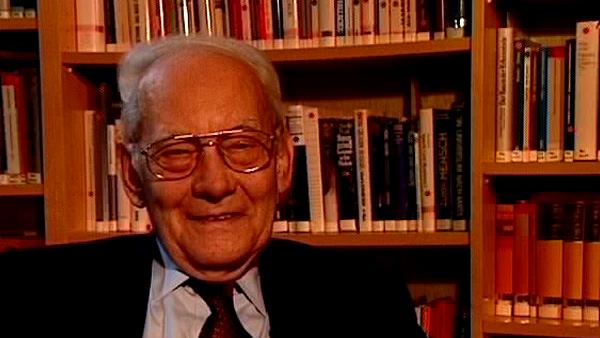NEXT STORY

Studying cage molecules
RELATED STORIES

NEXT STORY

Studying cage molecules
RELATED STORIES


|
Views | Duration | |
|---|---|---|---|
| 21. The birth of the relaxation methods | 352 | 06:10 | |
| 22. Damned fast reactions | 241 | 04:33 | |
| 23. The fast diffusion of proton and hydroxyl ions | 211 | 04:58 | |
| 24. A new successor at the University Institute of Physical Chemistry | 171 | 01:12 | |
| 25. Almost becoming a coordination chemist | 236 | 03:32 | |
| 26. Creating a periodic table of reaction rates | 180 | 02:44 | |
| 27. Studying cage molecules | 149 | 04:57 | |
| 28. Building T-jump machines | 178 | 01:16 | |
| 29. Becoming President of EMBO | 172 | 02:25 | |
| 30. Trying to set up the Max Planck Society Institute of Music | 236 | 05:13 |


[Q] Can you just mention some of the names, let's say Europe - from Denmark to south, Italy, or from the United States, just to get the feeling?
Yes, well one of the great inorganic chemists in Europe was Gerold Schwarzenbach in Zurich, Lars Gunnar Selèn [sic] in Stockholm, who in fact had invited me already in 1953 to present a lecture there at a meeting, and Jannik Bjerrum in Copenhagen. A famous inorganic chemist, of course, one who later received a Nobel Prize was Henry Taube, at that time he still was in Chicago, now he's in Stanford, and Jack Halpern and many others.
[Q] I understand your place became a mecca for measuring mechanisms of inorganic chemistry with ligands and later on also with organic compounds.
Yes, let me try to explain it a little more. I said before that a metal ion surrounds itself with two shells of water molecules, and if it combines with a ligand, that ligand has to penetrate through this water shell. And the chemists had, following nomenclature by Ingolt, had called it substitution of first order or second order as a rate limiting step. First order he would mean that before a ligand can enter the shell, a water molecule leaves, it's a first order reaction, then the ligand can move in. And the second order means that the ligand first comes in and replaces a water molecule from the shell. We could clarify many such reactions, and we really got a periodic table of reaction rates, all rates between, well, for the main group elements, for the alkali, the alkaline earth, the earth metals, for the transition elements, and we really could correlate this with electronic structure and so this clarified a whole field.
Nobel Prize winning German biophysical chemist, Manfred Eigen (1927-2019), was best known for his work on fast chemical reactions and his development of ways to accurately measure these reactions down to the nearest billionth of a second. He published over 100 papers with topics ranging from hydrogen bridges of nucleic acids to the storage of information in the central nervous system.
Title: Creating a periodic table of reaction rates
Listeners: Ruthild Winkler-Oswatitch
Ruthild Winkler-Oswatitsch is the eldest daughter of the Austrian physicist Klaus Osatitsch, an internationally renowned expert in gas dynamics, and his wife Hedwig Oswatitsch-Klabinus. She was born in the German university town of Göttingen where her father worked at the Kaiser Wilhelm Institute of Aerodynamics under Ludwig Prandtl. After World War II she was educated in Stockholm, Sweden, where her father was then a research scientist and lecturer at the Royal Institute of Technology.
In 1961 Ruthild Winkler-Oswatitsch enrolled in Chemistry at the Technical University of Vienna where she received her PhD in 1969 with a dissertation on "Fast complex reactions of alkali ions with biological membrane carriers". The experimental work for her thesis was carried out at the Max Planck Institute for Physical Chemistry in Göttingen under Manfred Eigen.
From 1971 to the present Ruthild Winkler-Oswatitsch has been working as a research scientist at the Max Planck Institute in Göttingen in the Department of Chemical Kinetics which is headed by Manfred Eigen. Her interest was first focused on an application of relaxation techniques to the study of fast biological reactions. Thereafter, she engaged in theoretical studies on molecular evolution and developed game models for representing the underlying chemical proceses. Together with Manfred Eigen she wrote the widely noted book, "Laws of the Game" (Alfred A. Knopf Inc. 1981 and Princeton University Press, 1993). Her more recent studies were concerned with comparative sequence analysis of nucleic acids in order to find out the age of the genetic code and the time course of the early evolution of life. For the last decade she has been successfully establishing industrial applications in the field of evolutionary biotechnology.
Tags: Nobel Prize, rate limiting step, first order reaction, second order reaction, reaction rates, Gerold Karl Schwarzenbach, Jannik Bjerrum, Henry Taube, Jack Halpern, Marek Ingolt
Duration: 2 minutes, 45 seconds
Date story recorded: July 1997
Date story went live: 24 January 2008